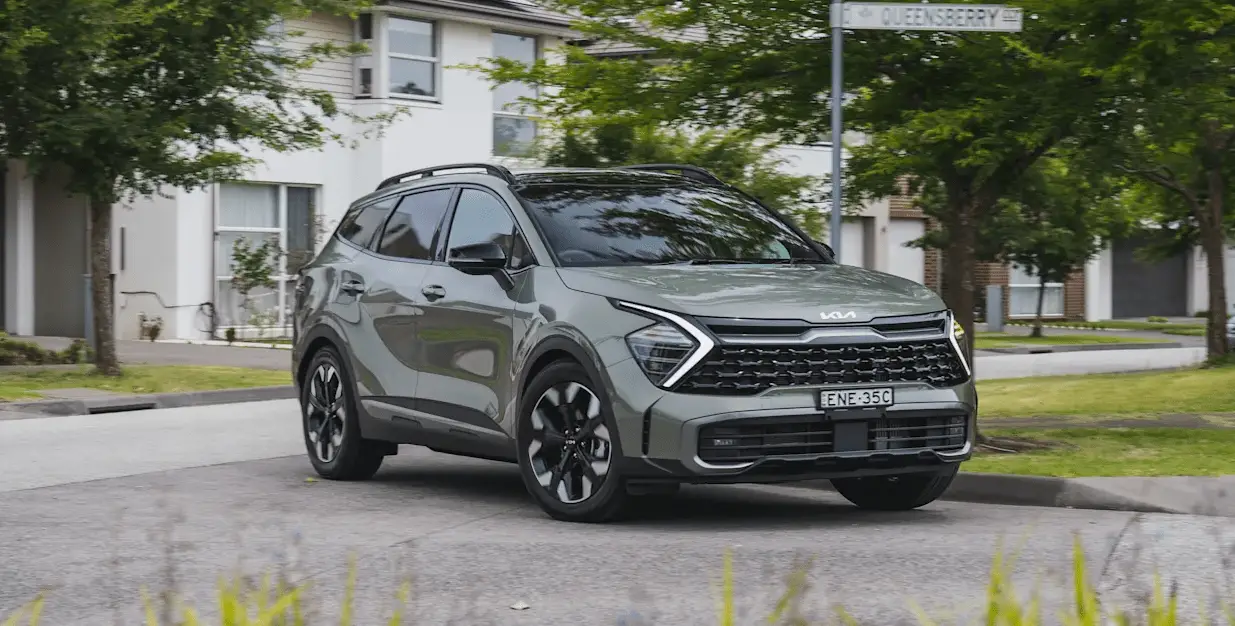Kia Sportage 2022 Brake System
The Kia Sportage 2022 is a compact SUV equipped with advanced safety features, including an advanced brake system. The brake system is designed to give drivers enhanced stopping power and control, keeping them safe on the road. The Kia Sportage 2022 brake system utilizes both hydraulic and electronic systems to provide the best stopping power. It has four-wheel disc brakes, an anti-lock braking system (ABS), electronic brake-force distribution (EBD), and brake assist (BA). The anti-lock braking system (ABS) prevents the wheels from locking up during hard braking, enabling the driver to maintain steering control. The electronic brake-force distribution (EBD) system adjusts the amount of braking force applied to each wheel, ensuring maximum stopping power. In emergency situations, the brake assist (BA) system is activated to provide additional stopping power. When the driver applies the brakes in an emergency situation, the system detects it and applies maximum brake force, reducing stopping distance and preventing collisions. Overall, the brake system in the Kia Sportage 2022 is a critical safety feature that gives drivers enhanced stopping power and control, ensuring their safety on the road.
2023 KIA SPORTAGE Specs, Price, Features and Mileage (Brochure)
Brake system
Power brakes
Your vehicle has power-assisted brakes that adjust automatically through normal usage. In the event that the power-assisted brakes lose power because of a stalled engine or some other reason, you can still stop your vehicle by applying greater force to the brake pedal than you normally would. The stopping distance, however, will be longer. When the engine is not running, the reserve brake power is partially depleted each time the brake pedal is applied. Do not pump the brake pedal when the power assist has been interrupted. Pump the brake pedal only when necessary to maintain steering control on slippery surfaces.
Brake Pedal
Do not drive with your foot resting on the brake pedal. This will create abnormally high brake temperatures which can cause excessive brake lining and pad wear.
Steep hill braking
Avoid continuous application of the brakes when descending a long or steep hill by shifting to a lower gear. Continuous brake application will cause the brakes to overheat and could result in a temporary loss of braking performance. Wet brakes may impair the vehicle’s ability to safely slow down; the vehicle may also pull to one side when the brakes are applied. Applying the brakes lightly will indicate whether they have been affected in this way. Always test your brakes in this fashion after driving through deep water. To dry the brakes, apply them lightly while maintaining a safe forward speed until brake performance returns to normal.
In the event of brake failure
If service brakes fail to operate while the vehicle is in motion, you can make an emergency stop with the parking brake. The stopping distance, however, will be much greater than normal.
Parking brake
Avoid applying the parking brake to stop the vehicle while it is moving except in an emergency situation. Applying the parking brake while the vehicle is moving at normal speeds can cause a sudden loss of control of the vehicle. If you must use the parking brake to stop the vehicle, use great caution in applying the brake.
Disc brakes wear indicator
When your brake pads are worn and new pads are required, you will hear a high-pitched warning sound from your front brakes or rear brakes. You may hear this sound come and go or it may occur whenever you depress the brake pedal. Please remember that some driving conditions or climates may cause a brake squeal when you first apply (or lightly apply) the brakes. This is normal and does not indicate a problem with your brakes. Always replace the front or rear brake pads as pairs.
Replace brake pads
Do not continue to drive with worn brake pads. Continuing to drive with worn brake pads can damage the braking system and result in costly brake repairs.
Brake wear
Do not ignore high-pitched wear sounds from your brakes. If you ignore this audible warning, you will eventually lose braking performance, which could lead to a serious accident.
Foot type (if equipped)
Applying the parking brake
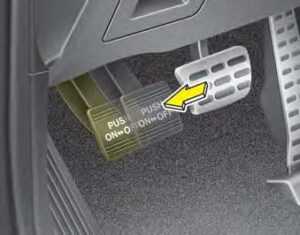
To engage the parking brake, first apply the foot brake and then depress the parking brake pedal down as far as possible.
Parking brake
Driving with the parking brake applied will cause excessive brake pad (or lining) and brake rotor wear.
Releasing the parking brake
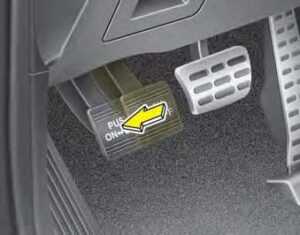
To release the parking brake, depress the parking brake pedal a second time while applying the foot brake. The pedal will automatically extend to the fully released position.
Parking brake use
All vehicles should always have the parking brake fully engaged when parked to avoid inadvertent movement of the vehicles which can injure occupants or pedestrians.
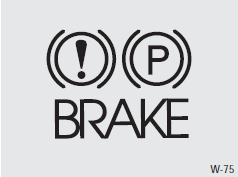
Check the brake warning light by turning the ignition switch ON (do not start the engine). This light will be illuminated when the parking brake is applied with the ignition switch in the START or ON position.
Before driving, be sure the parking brake is fully released and the brake warning light is off. If the brake warning light remains on after the parking brake is released while the engine is running, there may be a malfunction in the brake system. Contact an authorized Kia dealer as soon as possible. If at all possible, cease driving the vehicle immediately. If that is not possible, use extreme caution while operating the vehicle and only continue to drive the vehicle until you can reach a safe location or repair shop.
Electronic Parking Brake (EPB) (if equipped)
Applying the parking brake
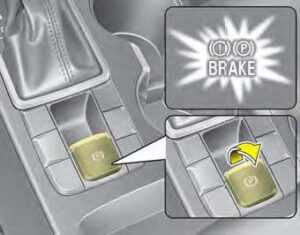 To apply the EPB (Electronic Parking Brake):
To apply the EPB (Electronic Parking Brake):
- Depress the brake pedal.
- Pull up the EPB switch.
Make sure the warning light comes on. Also, the EPB is applied automatically if the Auto Hold button is on when the engine is turned off. However, if you press the EPB switch after the engine is turned off, the EPB will not be Applied.
NOTICE
On a steep incline or when pulling a trailer, if the vehicle does not remain at a standstill, do as follows:
- Apply the EPB.
- Pull up the EPB switch for more than 3 seconds.
Do not operate the parking brake/EPB while the vehicle is moving except in an emergency situation.
NOTICE
A click or electric brake motor whine sound may be heard while operating or releasing the EPB, but these conditions are normal and indicate that the EPB is functioning properly.
Releasing the parking brake
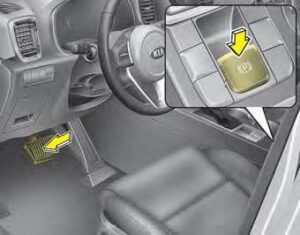
To release the EPB (Electronic Parking Brake), press the EPB switch while doing the following:
- Have the ignition switch or engine start/stop button in the ON position.
- Depress the brake pedal.
- The shift lever must be in P (Park).
- Make sure the brake warning light goes off.
To release EPB (Electronic Parking Brake) automatically:
- Shift lever in P (Park)
- With the engine running depress the brake pedal and shift out of P (Park) to R (Reverse) or D (Drive).
- Shift lever in N (Neutral)
- With the engine running depress the brake pedal and shift out of N (Neutral) to R (Reverse) or D (Drive).
- Automatic Transmission
- Start the engine.
- Fasten the driver’s seat belt.
- Close the driver’s door, engine hood and tailgate.
- Depress the accelerator pedal while the shift lever is in R (Rear), D (Drive) or manual mode.
- Make sure the brake warning light goes off.
NOTICE
For your safety, you can engage the EPB even though the ignition switch or engine stop/start button is in the OFF position, but you cannot release it. For your safety, depress the brake pedal and release the parking brake manually with the EPB switch when you drive downhill or when backing up the vehicle. Do not follow the above procedure when driving on a flat level ground. The vehicle may suddenly move forward.
NOTICE
If the parking brake warning light is still on even though the EPB has been released, have the system checked by an authorized Kia dealer.
CAUTION
Do not drive your vehicle with the EPB applied. It may cause excessive brake pad and brake rotor wear.
EPB (Electronic Parking Brake) may be automatically applied when:
- The EPB is overheated
- Requested by other systems
NOTICE
For EPB (Electronic Parking Brake) equipped vehicles with AUTO HOLD function used while driving, if the ignition button has been turned OFF, the EPB will be engaged automatically. Therefore, the AUTO HOLD function should be turned off before the ignition button is turned off.
System warning
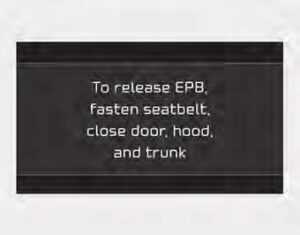
- If you try to drive off by depressing the accelerator pedal with the EPB applied, but the EPB doesn’t release automatically, a warning will sound and a message will appear. If the driver’s seat belt is not fastened and the engine hood, driver’s door, or trunk is opened, a warning will sound and a message will appear. If there is a problem with the vehicle, a warning may sound and a message may appear.
If the above situation occurs, depress the brake pedal and release EPB by pressing the EPB switch.
WARNING
Parking Brake Use
All vehicles should always have the parking brake fully engaged when parked to avoid inadvertent movement of the car which can injure occupants or pedestrians.
- A click or electric brake motor whine sound may be heard while operating or releasing the EPB, but these conditions are normal and indicate that the EPB is functioning properly.
- When leaving your keys with a parking lot attendant or valet, make sure to inform him/her how to operate the EPB.
- The EPB may malfunction if you drive with the EPB applied.
- When you automatically release EPB by depressing the accelerator pedal, depress it slowly.
System warning

When the conversion from Auto Hold to EPB is not working properly a warning will sound and a message will appear.
NOTICE
Depress the brake pedal when the above message appears for the Auto Hold and EPB may not activate.
System warning
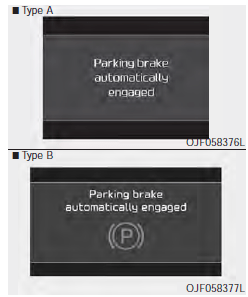
If the EPB is applied while Auto Hold is activated because of the ESC (Electronic Stability Control) signal, a warning will sound and a message will appear.
EPB malfunction indicator (if equipped)
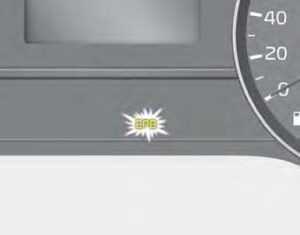
This warning light illuminates if the engine start/stop button is changed to the ON position and goes off in approximately 3 seconds if the system is operating normally. If the EPB malfunction indicator remains on, comes on while driving, or does not come on when the ignition switch or the engine start/stop button is changed to the ON position, this indicates that the EPB may have malfunctioned. If this occurs, have your vehicle checked by an authorized Kia dealer as soon as possible. The EPB malfunction indicator may illuminate when the ESC indicator comes on to indicate that the ESC is not working properly, but it does not indicate a malfunction of the EPB.
- The EPB warning light may illuminate if the EPB switch operates abnormally. Shut the engine off and turn it on again after a few minutes. The warning light will go off and the EPB switch will operate normally. However, if the EPB warning light is still on, have the system checked by an authorized Kia dealer.
- If the parking brake warning light does not illuminate or blinks even though the EPB switch was pulled up, the EPB is not applied.
- If the parking brake warning light blinks when the EPB warning light is on, press the switch, then pull it up. Once more press it back to its original position and pull it back up. If the EPB warning does not go off, have the system checked by an authorized Kia dealer.
Emergency braking
If there is a problem with the brake pedal while driving, emergency braking is possible by pulling up and holding the EPB switch. Braking is possible only while you are holding the EPB switch.
WARNING
Do not operate the Electronic Parking Brake while the vehicle is moving except in an emergency situation. Applying the Electronic Parking Brake while the vehicle is moving at normal speeds can cause a sudden loss of control of the vehicle. If you must use the Electronic Parking Brake to stop the vehicle, use great caution in applying the brake.
NOTICE
During emergency braking by the EPB, the parking brake warning light will illuminate to indicate that the system is operating. If you notice a continuous noise or burning smell when the EPB is used for emergency braking, have your vehicle checked by an authorized Kia dealer.
When the EPB (Electronic Parking Brake) is not released
If the EPB does not release normally, take your vehicle to an authorized Kia dealer by loading the vehicle on a flatbed tow truck and have the system checked.
AUTO HOLD (if equipped)
The Auto Hold maintains the vehicle at a standstill even though the brake pedal is not depressed after the driver brings the vehicle to a complete stop by depressing the brake pedal.

- Depress the brake pedal, start the engine, and then press the Auto Hold button. The white AUTO HOLD indicator will come on indicating the system is in standby.
- Before the Auto Hold will engage, the driver’s door and engine hood must be closed and the driver’s seat belt must be fastened.

- When coming to a complete stop by depressing the brake pedal, the AUTO HOLD indicator changes from white to green indicating the AUTO HOLD is engaged and EPB is applied. The vehicle will remain at a standstill even if you release the brake pedal.
- If EPB is applied, Auto Hold will be released.
- If you press the accelerator pedal with the shift lever in D (Drive) or manual mode, the Auto Hold will be released automatically and the vehicle will start to move. The indicator changes from green to white indicating the Auto Hold is in standby and the EPB is released. When driving off from Auto Hold by depressing the accelerator pedal, always check the surrounding area near your vehicle. Slowly depress the accelerator pedal for a smooth launch.
Cancel
To cancel the Auto Hold operation, press the Auto Hold switch. The AUTO HOLD indicator will go out. To cancel the Auto Hold operation when the vehicle is at a standstill, press the Auto Hold switch while depressing the brake pedal.
NOTICE
- The following are conditions when the Auto Hold will not engage (Auto Hold light will not turn green and the Auto Hold system remains in stand-by):
- The driver’s seat belt is unfastened and the driver’s door is opened
- The engine hood is opened
- The shift lever is in P (Park) or R (Reverse)
- The EPB is applied
- For your safety, the Auto Hold automatically switches to EPB under any of the following conditions (the Auto Hold light remains white and the EPB automatically applies):
- The driver’s seat belt is unfastened and the driver’s door is opened
- The engine hood is opened
- The vehicle is at a standstill for more than 10 minutes
- The vehicle is standing on a steep slope
- The vehicle moved several times
In these cases, the brake warning light comes on, the AUTO HOLD indicator changes from green to white, and a warning sounds and a message will appear to inform you that EPB has been automatically engaged. Before driving off again, press the foot brake pedal, check the surrounding area near your vehicle, and release the parking brake manually with the EPB switch.
-
- If the AUTO HOLD indicator lights up yellow, the Auto Hold is not working properly. Take your vehicle to an authorized Kia dealer and have the system checked.
WARNING
To reduce the risk of an accident, do not activate Auto Hold while driving downhill, backing up, or parking your vehicle. If there is a malfunction with the driver’s door or engine hood open detection system, the Auto Hold may not work properly. Take your vehicle to an authorized Kia dealer and have the system checked.
NOTICE
A click or electric brake motor whine sound may be heard while operating or releasing the EPB, but these conditions are normal and indicate that the EPB is functioning properly.
Warning messages

The parking brake automatically locked
When the EPB is applied from Auto Hold, a warning will sound and a message will appear.
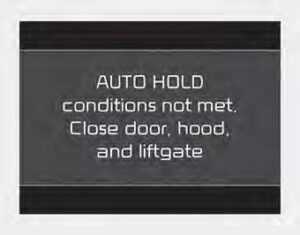
AUTO HOLD conditions not met. Close the door, hood, and liftgate
When you press the [AUTO HOLD] switch, if the driver’s door and engine hood are not closed or the driver’s seat belt is unfastened, a warning will sound and a message will appear on the LCD display. At this moment, press the [AUTO HOLD] button after closing the driver’s door, engine hood, and liftgate.
Anti-lock brake system (ABS)
ABS (or ESC) will not prevent accidents due to improper or dangerous driving maneuvers. Even though vehicle control is improved during emergency braking, always maintain a safe distance between you and objects ahead. Vehicle speeds should always be reduced during extreme road conditions.
The vehicle should be driven at reduced speeds in the following circumstances:
- When driving on rough, gravel, or snow-covered roads
- When driving with tire chains installed
- When driving on roads where the road surface is pitted or has different surface heights.
Driving in these conditions increases the stopping distance for your vehicle.
The ABS continuously senses the speed of the wheels. If the wheels are going to lock, the ABS system repeatedly modulates the hydraulic brake pressure on the wheels. When you apply your brakes under conditions that may lock the wheels, you may hear a “tiktik’’ sound from the brakes, or feel a corresponding sensation in the brake pedal. This is normal and it means your ABS is active. In order to obtain the maximum benefit from your ABS in an emergency situation, do not attempt to modulate your brake pressure, and do not try to pump your brakes. Press your brake pedal as hard as possible or as hard as the situation allows the ABS to control the force being delivered to the brakes.
NOTICE
A click/clunk type sound may be heard once per ignition cycle in the engine compartment when the vehicle begins to move after the engine is started. These conditions are normal and indicate that the anti-lock brake system is functioning properly.
- Even with the anti-lock brake system, your vehicle still requires sufficient stopping distance. Always maintain a safe distance from the vehicle in front of you.
- Always slow down when cornering. The anti-lock brake system cannot prevent accidents resulting from excessive speeds.
- On loose or uneven road surfaces, the operation of the anti-lock brake system may result in a longer stopping distance than for vehicles equipped with a conventional brake system.

The ABS warning light will stay on for approximately 3 seconds after the ignition switch is ON. During that time, the ABS will go through self-diagnosis and the light will go off if everything is normal. If the light stays on, you may have a problem with your ABS. Contact an authorized Kia dealer as soon as possible. When you drive on a road having poor traction, such as an icy road, and have operated your brakes continuously, the ABS will be active continuously and the ABS warning light may illuminate. Pull your vehicle over to a safe place and stop the engine. Restart the engine. If the ABS warning light goes off, then your ABS system is normal. Otherwise, you may have a problem with the ABS. Contact an authorized Kia dealer as soon as possible.
NOTICE
When you jump start your vehicle because of a drained battery, the engine may not run as smoothly and the ABS warning light may turn on at the same time. This happens because of low battery voltage. It does not mean your ABS has malfunctioned.
- Do not pump your brakes!
- Have the battery recharged before driving the vehicle.
Electronic stability control (ESC)
The Electronic Stability Control (ESC) system is designed to stabilize the vehicle during cornering maneuvers. ESC checks where you are steering and where the vehicle is actually going. ESC applies the brakes at individual wheels and intervenes with the engine management system to stabilize the vehicle.
WARNING
Never drive too fast for the road conditions or too quickly when cornering. Electronic stability control (ESC) will not prevent accidents. Excessive speed in turns, abrupt maneuvers, and hydroplaning on wet surfaces can still result in serious accidents. Only a safe and attentive driver can prevent accidents by avoiding maneuvers that cause the vehicle to lose traction. Even with ESC installed, always follow all the normal precautions for driving – including driving at safe speeds for the conditions.
The Electronic stability control (ESC) system is an electronic system designed to help the driver maintain vehicle control under adverse conditions. It is not a substitute for safe driving practices. Factors including speed, road conditions and driver steering input can all affect whether ESC will be effective in preventing a loss of control. It is still your responsibility to drive and corner at reasonable speeds and to leave a sufficient margin of safety. When you apply your brakes under conditions that may lock the wheels, you may hear a “tiktik’’ sound from the brakes, or feel a corresponding sensation in the brake pedal. This is normal and it means your ESC is active.
NOTICE
A click/clunk type sound may be heard once per ignition cycle in the engine compartment when the vehicle begins to move after the engine is started. These conditions are normal and indicate that the Electronic Stability Control (ESC) System is functioning properly.
ESC operation
ESC ON condition
When the ignition is turned ON, ESC and ESC OFF indicator lights illuminate for approximately 3 seconds, then ESC is turned on. Select the LCD display ESC ESC OFF/ESC OFF (TCS OFF) ESC OFF indicator will illuminate. Select the ESC ON, ESC OFF indicator light will go off. When starting the engine, you may hear a slight ticking sound. This is the ESC performing an automatic system self-check and does not indicate a problem.
When operating
When the ESC is in operation, the ESC indicator light blinks.
- When the Electronic Stability Control is operating properly, you can feel a slight pulsation in the vehicle. This is only the effect of brake control and indicates nothing unusual. When moving out of the mud or slippery road, the engine rpm (revolution per minute) may not increase even if you press the accelerator pedal deeply. This is to maintain the stability and traction of the vehicle and does not indicate a problem.
ESC operation off
ESC OFF state
This car has 2 kinds of ESC off-states. If the engine stops when ESC is off, ESC remains off. Upon restarting the engine, the ESC will automatically turn on again.
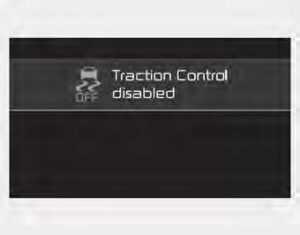
- ESC off state 1
To cancel the ESC operation, Select the ESC OFF (TCS OFF) in the ESC. ESC OFF indicator light (ESC OFF ) illuminates). At this state, the engine control function does not operate. It means the traction control function does not operate. The brake control function only operates.

- ESC off state 2
To cancel ESC operation, Select the ESC OFF in the ESC (ESC OFF indicator light (ESC OFF ) illuminates. At this state, the engine control function and brake control function do not operate. It means the car stability control function does not operate anymore.
Indicator light

When the ignition switch is turned to ON, the indicator light illuminates and then goes off if the ESC system is operating normally. The ESC indicator light blinks whenever the ESC is operating or illuminates when the ESC fails to operate. THE ESC OFF indicator light comes on when they select the ESC OFF/ESC OFF (TCS OFF) in the LCD display.
CAUTION
Driving with varying tire or wheel sizes may cause the ESC system to malfunction. When replacing tires, make sure they are the same size as your original tires.
WARNING
The Electronic Stability Control system is only a driving aid that can assist you in maintaining control under certain circumstances. Use precautions for safe driving by slowing down on curved, snowy, or icy roads. Drive slowly and don’t attempt to accelerate whenever the ESC indicator light is blinking, or when the road surface is slippery.
ESC OFF usage
When driving
ESC should be turned on for daily driving whenever possible. To turn ESC off while driving, select the ESC OFF/ESC OFF(TCS OFF) in the LCD display while driving on a flat road surface.
WARNING
Never select the ESC OFF/ ESC OFF(TCS OFF) in the LCD display while ESC is operating (ESC indicator light blinks).
NOTICE
When operating the vehicle on a dynamometer, ensure that you select the LCD display ESC ESC OFF/ESC OFF (TCS OFF)(ESC OFF light illuminated). If the ESC is left on, it may prevent the vehicle speed from increasing, and result in false diagnosis. Turning the ESC off does not affect ABS or brake system operation.
Downhill Brake Control (DBC)
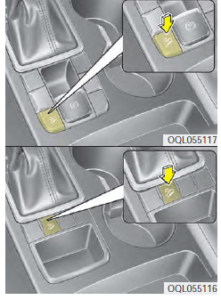
The Downhill Brake Control (DBC) allows the vehicle to descend from a steep hill without depressing the brake pedal. It slows down the vehicle under 5 mph (8 km/h) and allows the driver to concentrate on steering the vehicle.
WARNING
Always turn off the DBC on normal roads. The DBC might activate inadvertently from the standby mode when driving through speed bumps or making sharp curves increasing the risk of a crash.
WARNING
The DBC is a supplemental system only and is not a substitute for safe driving practices. A driver should not solely rely on this system when descending from a hill and should always be ready to apply the brakes depending on road and traffic conditions.
NOTICE
The DBC defaults to the OFF position whenever the ignition switch is placed in the ON position. Noise or vibration may occur from the brakes when the DBC is activated. The rear stop light comes on when DBC is activated.
DBC operation
| Mode | Indicator light | Description |
Standby |
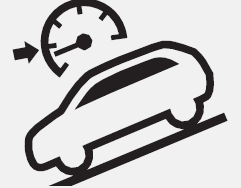
illuminated |
Press the DBC button when vehicle speed is under 25 mph (40 km/h). The DBC system will turn ON and enter the standby mode. The system does not turn ON if vehicle speed is over 25 mph (40 km/h). |
|
Activated |

blinks |
In the standby mode, if vehicle speed is under 22 mph (35 km/h) while driving down a steep hill, the DBC will activate automatically. |
Temporarily deactivated |

illuminated |
In the activated mode, the DBC will temporarily deactivate under the following conditions:
• The hill is not steep enough. • The brake pedal or accelerator pedal is depressed. If the above conditions are gone, the DBC will automat- ically activate again. |
OFF |

not illuminated |
The DBC will turn OFF under the following conditions: • The DBC button is pressed again. • Vehicle speed is over 38 mph (60 km/h). |
NOTICE
If the DBC red indicator light illuminates, the system may have overheated or malfunctioned. When the warning light illuminates even though the DBC system has cooled off, we recommend that the vehicle be checked by an authorized Kia dealer as soon as possible.
NOTICE
- The DBC may not deactivate on steep inclines even though the brake or accelerator pedal is depressed.
- The DBC does not operate when:
- The shift lever is in P (Park).
- The ESC is activated.
Good braking practices
Wet brakes can be dangerous! The brakes may get wet if the vehicle is driven through standing water or if it is washed. Your vehicle will not stop as quickly if the brakes are wet. Wet brakes may cause the vehicle to pull to one side.
WARNING
Whenever leaving the vehicle or parking, always come to a complete stop and continue to depress the brake pedal. Move the shift lever into the P (Park) position, then apply the parking brake, and place the Engine Start/Stop button in the OFF position. Vehicles with the parking brake not fully engaged are at risk of moving inadvertently and causing injury to yourself or others.
To dry the brakes, apply the brakes lightly until the braking action returns to normal, taking care to keep the vehicle under control at all times. If the braking action does not return to normal, stop as soon as it is safe to do so and we recommend that you call an authorized Kia dealer for assistance. DO NOT drive with your foot resting on the brake pedal. Even light, but constant pedal pressure can result in the brakes overheating, brake wear, and possibly even brake failure. If a tire goes flat while you are driving, apply the brakes gently and keep the vehicle pointed straight ahead while you slow down. When you are moving slowly enough for it to be safe to do so, pull off the road and stop in a safe location. Keep your foot firmly on the brake pedal when the vehicle is stopped to prevent the vehicle from rolling forward.
Vehicle stability management (VSM)
This system provides further enhancements to vehicle stability and steering responses when a vehicle is driving on a slippery road or a vehicle detects changes in the coefficient of friction between the right wheels and left wheels when braking.
WARNING
Tire/ Wheel size
When replacing tires and wheels, make sure they are the same size as the original tires and wheels installed. Driving with varying tire or wheel sizes may diminish any supplemental safety benefits of the VSM system.
VSM operation
When the VSM is in operation, the ESC indicator light () blinks. When the vehicle stability management is operating properly, you can feel a slight pulsation in the vehicle and/or abnormal steering responses (EPS- Electronic Power Steering). This is only the effect of brake and EPS control and indicates nothing unusual.
The VSM does not operate when:
- Driving on a sloping road such as a gradient or incline
- Driving in reverse
- ESC OFF indicator light ( ) remains on the instrument cluster
- The EPS indicator light remains on the instrument cluster
VSM operation off
If you select the LCD display ESC ESC OFF/ESC OFF (TCS OFF) the VSM will also cancel and the ESC OFF indicator light ( ) will illuminate. To turn on the VSM, select ESC OFF/ESC OFF (TCS OFF). The ESC OFF indicator light goes out.
WARNING
Vehicle stability management
Drive carefully even though your vehicle has Vehicle stability management. It can only assist you in maintaining control under certain circumstances.
Malfunction indicator
The VSM can be deactivated even if you don’t cancel the VSM operation by selecting the ESC OFF/ESC OFF (TCS OFF). It indicates that a malfunction has been detected somewhere in the Electric Power Steering system or VSM system. If the ESC indicator light ( ) or EPS warning light remains on, take your vehicle to an authorized Kia dealer and have the system checked.
NOTICE
The VSM is designed to function above approximately 13 mph (22 km/h) on curves. The VSM is designed to function above approximately 6 mph (10 km/h) when a vehicle is braking on a split-mu surface. A split-mu surface is made of two surfaces that have different friction forces. The Vehicle Stability Management system is not a substitute for safe driving practices but a supplementary function only. It is the responsibility of the driver to always check the speed and the distance to the vehicle ahead. Always hold the steering wheel firmly while driving. Your vehicle is designed to activate according to the driver’s intention, even with installed VSM. Always follow all the normal precautions for driving at safe speeds for the conditions – including driving in clement weather and on a slippery road.
WARNING
For maximum protection, always wear your seat belt. No system, no matter how advanced, can compensate for all driver errors and/or driving conditions. Always drive responsibly.
Hill-start assist control (HAC)
A vehicle has the tendency to roll back on a steep hill when it starts to go after stopping. The Hill-start Assist Control (HAC) prevents the vehicle from rolling back by applying the brakes automatically for about 2 seconds. The brakes are released when the accelerator pedal is depressed or after about 2 seconds. The HAC is activated only for about 2 seconds, so when the vehicle is starting off always depress the accelerator pedal.
Maintaining Brake Pressure on the Incline
HAC does not replace the need to apply brakes while stopped on an incline. While stopped, make sure you maintain brake pres-sure sufficient to prevent your vehicle from rolling backward and causing an accident. Don’t release the brake pedal until you are ready to accelerate forward.
Good braking practices
- Check to be sure the parking brake is not engaged and the parking brake indicator light is out before driving away.
- Driving through water may get the brakes wet. They can also get wet when the vehicle is washed. Wet brakes can be dangerous! Your vehicle will not stop as quickly if the brakes are wet. Wet brakes may cause the vehicle to pull to one side. To dry the brakes, apply the brakes lightly until the braking action returns to normal, taking care to keep the vehicle under control at all times. If the braking action does not return to normal, stop as soon as it is safe to do so and call an authorized Kia dealer for assistance.
- Don’t coast down hills with the vehicle out of gear. This is extremely hazardous. Keep the vehicle in gear at all times, use the brakes to slow down, and then shift to a lower gear so that engine braking will help you maintain a safe speed.
- Don’t “ride” the brake pedal. Resting your foot on the brake pedal while driving can be dangerous because the brakes might overheat and lose their effectiveness. It also increases the wear of the brake components.
- If a tire goes flat while you are driving, apply the brakes gently and keep the vehicle pointed straight ahead while you slow down. When you are moving slowly enough for it to be safe to do so, pull off the road and stop in a safe place.
- If your vehicle is equipped with an Automatic Transmission, don’t let your vehicle creep forward. To avoid creeping forward, keep your foot firmly on the brake pedal when the vehicle is stopped.
- Be cautious when parking on a hill. Firmly engage the parking brake and place the shift lever in P (automatic transmission). If your vehicle is facing downhill, turn the front wheels into the curb to help keep the vehicle from rolling.
- If your vehicle is facing uphill, turn the front wheels away from the curb to help keep the vehicle from rolling. If there is no curb or if it is required by other conditions to keep the vehicle from rolling, block the wheels.
- Under some conditions, your parking brake can freeze in the engaged position. This is most likely to happen when there is an accumulation of snow or ice around or near the rear brakes or if the brakes are wet. If there is a risk that the parking brake may freeze, apply it only temporarily while you put the shift lever in P (automatic transmission) and block the rear wheels so the vehicle cannot roll. Then release the parking brake.
- Do not hold the vehicle on an incline with the accelerator pedal. This can cause the transmission to overheat. Always use the brake pedal or parking brake.
DRIVE MODE INTEGRATED CONTROL SYSTEM
DRIVE mode
The drive mode may be selected according to the driver’s preference or road condition. The mode changes whenever the DRIVE MODE button is pressed. When normal mode is selected, it is not displayed on the cluster.
ECO mode (Active ECO)
Active ECO helps improve fuel efficiency by controlling certain engine and transmission system operating parameters. Fuel efficiency depends on the driver’s driving habits and road conditions.
- When the DRIVE MODE button is pressed and the ECO mode is selected, the ECO indicator (green) will illuminate to show that the Active ECO is operating.
- When the Active ECO is activated, it does not turn off even though the engine is restarted again. To turn off the system, press the DRIVE MODE button again.
When Active ECO is activated:
- The acceleration may slightly be reduced even though you depress the accelerator fully.
- The air conditioner’s performance may be limited
- The shift pattern of the automatic transmission may change.
- The engine noise may get louder.
The above situations are normal conditions when the Active Eco System is activated to improve fuel efficiency.
Limitation of Active ECO operation:
If the following conditions occur while Active ECO is operating, the system operation is limited even though there is no change in the ECO indicator.
- When the coolant temperature is low:
The system will be limited until engine performance becomes normal. - When driving up a hill:
The system will be limited to gain power when driving uphill because the engine torque is restricted. - When using manual mode:
The system will be limited according to the shift location. - When the accelerator pedal is deeply depressed for a few seconds:
The system will be limited, judging that the driver wants to speed up.
SPORT mode
SPORT mode focuses on dynamic driving by automatically adjusting the steering wheel, engine, and transmission system.
- When the DRIVE MODE button is pressed and the SPORT mode is selected, the SPORT indicator (yellow) will illuminate.
- When the SPORT mode is activated, and the engine starts/stop button is turned off and on it will change to NORMAL mode. To turn on the SPORT mode press the DRIVE MODE button again.
- If the system is activated:
- It maintains the gear and RPM for some time even though the accelerator pedal is not depressed.
- Up-shifting is delayed.
NOTICE
In Sport drive mode, the fuel efficiency may decrease.
FAQ
What kind of brake system does the Kia Sportage 2022 have?
The Kia Sportage 2022 comes equipped with a combination of hydraulic and electronic brake systems, including four-wheel disc brakes with an anti-lock braking system (ABS), electronic brake-force distribution (EBD), and brake assist (BA).
What is the anti-lock braking system (ABS) in the Kia Sportage 2022?
The ABS in the Kia Sportage 2022 helps prevent the wheels from locking up during hard braking, allowing the driver to maintain steering control.
What is the electronic brake-force distribution (EBD) system in the Kia Sportage 2022?
The EBD system in the Kia Sportage 2022 automatically adjusts the amount of braking force applied to each wheel, helping to ensure maximum stopping power.
What is the brake assist (BA) system in the Kia Sportage 2022?
The brake assist (BA) system in the Kia Sportage 2022 is designed to provide additional stopping power in emergency situations. When the system detects that the driver is applying the brakes in an emergency situation, it automatically applies maximum brake force to help reduce stopping distance and avoid a collision.
How does the brake system in the Kia Sportage 2022 help drivers stay safe on the road?
The brake system in the Kia Sportage 2022 provides enhanced stopping power and control, allowing drivers to stop more quickly and avoid collisions in emergency situations.
What is the advantage of having a brake system with both hydraulic and electronic components?
The combination of hydraulic and electronic components in the brake system allows for maximum stopping power and control, helping drivers stay safe on the road.
Does the Kia Sportage 2022 have disc brakes?
Yes, the Kia Sportage 2022 comes equipped with four-wheel disc brakes.
Can the Kia Sportage 2022 brake system prevent accidents?
While no system can prevent all accidents, the advanced brake system in the Kia Sportage 2022 can help drivers avoid collisions by providing enhanced stopping power and control.
Is the brake system in the Kia Sportage 2022 easy to use?
Yes, the brake system in the Kia Sportage 2022 is easy to use and provides drivers with enhanced stopping power and control.
Is the brake system in the Kia Sportage 2022 reliable?
Yes, the brake system in the Kia Sportage 2022 is reliable and designed to provide maximum stopping power and control.
Can the brake system in the Kia Sportage 2022 be customized?
While the brake system in the Kia Sportage 2022 cannot be customized, it is designed to provide drivers with maximum stopping power and control in a range of driving situations.
Is the brake system in the Kia Sportage 2022 covered by the warranty?
Yes, the brake system in the Kia Sportage 2022 is covered by the vehicle’s warranty.
How often should the brake system in the Kia Sportage 2022 be serviced?
The brake system in the Kia Sportage 2022 should be serviced according to the manufacturer’s recommended maintenance schedule.
Is the brake system in the Kia Sportage 2022 easy to maintain?
Yes, the brake system in the Kia Sportage 2022 is easy to maintain and should be serviced regularly to ensure maximum stopping power and control.
How does the brake system in the Kia Sportage 2022 compare to other compact SUVs?
The brake system in the Kia Sportage 2022 is designed to provide maximum stopping power and control, making it one of the safest and most advanced brake systems in the compact SUV category.
View Full User Guide: Kia Sportage 2022 User Guide
Download Manuals: https://owners.kia.com/content/owners/en/manuals.html
2023 KIA SPORTAGE Specs, Price, Features and Mileage (Brochure)

